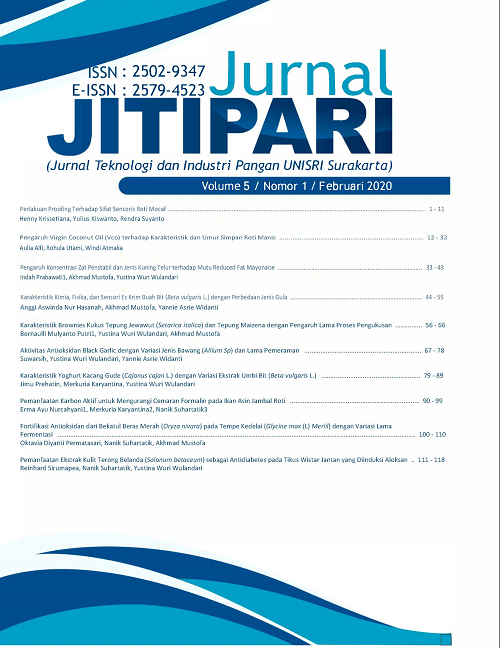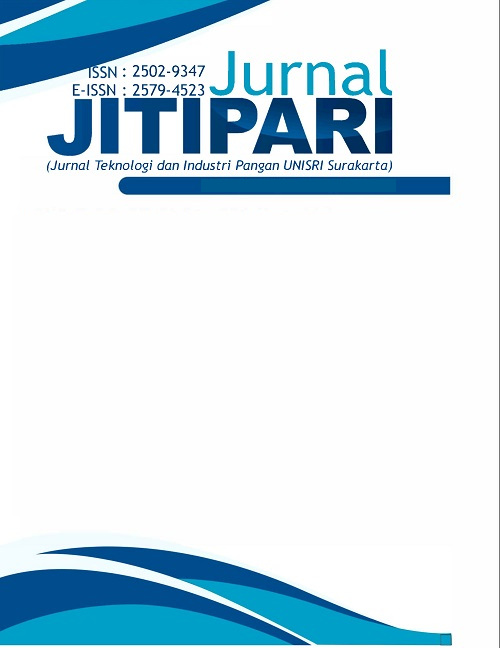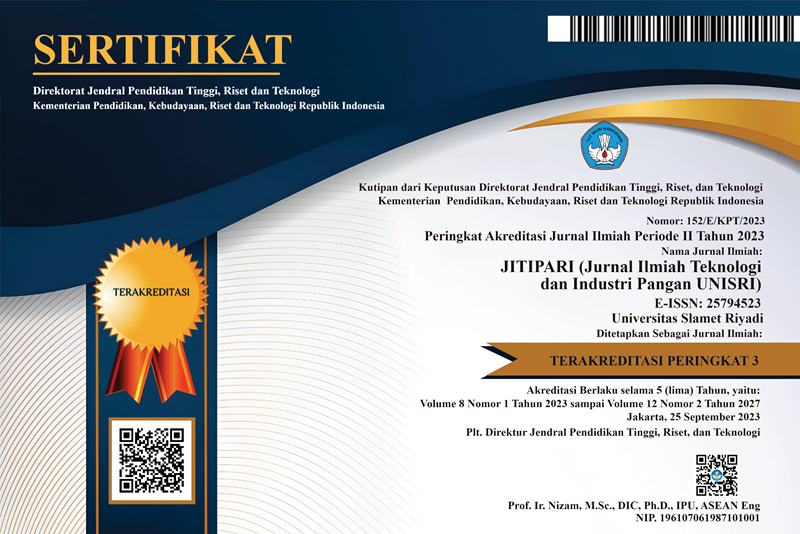PENGARUH KONSENTRASI ZAT PENSTABIL DAN JENIS KUNING TELUR TERHADAP MUTU REDUCED FAT MAYONNAISE
DOI:
https://doi.org/10.33061/jitipari.v5i1.3640Abstract
Mayones merupakan produk olahan telur yang memiliki kandungan lemak tinggi. Reduce fat mayonnaise merupakan salah satu jenis mayones yang memiliki kadar lemak rendah dibandingkan full fat mayonnaise. Penelitian dilakukan dengan menggunakan Rancangan Acak Lengkap (RAL) faktorial yang terdiri dari dua faktor. Faktor pertama jenis zat penstabil dengan berbagai konsentrasi CMC 2,06%, Maltodekstrin 82,43%, Xanthan gum 3,09%. Faktor kedua jenis kuning telur dengan konsentrasi setiap bahan 20,60% yaitu kuning telur ayam kampung, kuning telur ayam petelur, kuning telur ayam omega 3. Hasil penelitian ini menunjukkan bahwa perlakuan kombinasi yang mempunyai kadar lemak lebih rendah yaitu zat penstabil maltodekstrin 82,43% dengan kuning telur ayam omega 3 dengan konsentrasi 20,60% kombinasi perlakuan tersebut mengandung kadar air 28,651%, kadar lemak 45,650%, pH 4,5, viskositas 3,30 Pa.s, kadar gula total 0,897%, kadar protein 0,160%. Pada pengujian organoleptik yaitu warna putih kekuningan (3,3), tekstur lembut (3,97), tekstur creamy (3,46), kesukaan keseluruhan (paling disukai) (2,6), flavor (mayonnaise) (3,21). Pada penelitian ini kadar lemak masih cukup tinggi sehingga belum mencapai tujuan dari pembuatan reduce fat mayonnaise
Â
Kata kunci : Mayones, reduce fat mayonnaise, kuning telur ayam, zat penstabil
Â
 ABSTRACT
Mayonnaise is an processed egg product that has a high fat content. Reduce fat mayonnaise is one type of mayonnaise that has lower fat content compared to full fat mayonnaise. The study was conducted using a factorial Completely Randomized Design (CRD) consisting of two factors. The first factor was the type of stabilizer with 2.06% of CMC, 82.43% of maltodextrin and 3.09% of xanthan gum. The second factor was the type of egg yolk with 20.60% concentration of each ingredient, free range chicken egg yolk, broiler chicken egg yolk, omega 3 chicken egg yolk. The results of this study indicate that the combination treatment which has lower fat content was 82.43% of maltodextrin with omega 3 chicken egg yolk of 20.60%. The treatment combination contains 28.651% of water content, 45.650% of fat content, pH 4.5, viscosity 3.30 Pa.s, total sugar content of 0.897%, protein content of 0.160%. In organoleptic testing, they are color (yellowish white) (3.3), soft texture (3.97), creamy texture (3,46), overall preference (most preferred) (2.6), flavor mayonnaise (3.21). The result of study the fat content was still high so that it has not reached the goal of reduced fat mayonnaise.
Â
Keywords: Mayonnaise, reduce fat mayonnaise, chicken egg yolk, stabilizing agent
References
Al Bachir, M.,& Zeinou,R. (2006). Effect of gamma iradiation eggs and mayonnaise prepared from irradiation eggs. Journal of Food Safety, 26(1), 346-360.
Amin, M.H.H., Elbeltagy, A.E., Mustafa, M., & Khalil, A.H. (2014). Development of low fat mayonnaise containing different types and levels of hydrocolloid gum. Journal of Aglimentary Processes and Technologies. 20(1), 54-63
Badan Standarisasi Nasional. (1998). Standar mutu mayonnaise (SNI- 01-4473-1998). Jakarta: Badan Standarisasi Nasional
Badan Standarisasi Nasional. (2006). Cara uji kimia-bagian 2: Penentuan kadar air pada produk perikanan (SNI 01-2354.2.2006). Jakarta: Badan Standarisasi Nasional.
Baktra, D.D.A., Rusdi & .Mardiah, A. (2016). Penetapan kadar protein dalam telur unggas melalui analisis nitrogen menggunakan metode kjedahl. Jurnal Farmasi Higea, 8(2),1-8.
Direktorat Gizi Departemen Kesehatan RI. (1981). Komposisi kimia telur ayam Kampung. Jakarta: Direktorat Gizi Departemen Kesehatan RI.
Direktorat Gizi Departemen Kesehatan RI. (2004). Komposisi kimia telur ayam petelur. Jakarta: Direktorat Gizi Departemen Kesehatan RI.
Garcia, KM. (2006). Quality characterization of cholesterol free mayonnaise type spreads containing rice bran oil. Louisiana State University
Harbone, J.B. (1987). Metode fitokimia penentuan cara modern menganalisis tumbuhan. Bandung: Institut Teknologi Bandung
Harrison L.J., & F.E. Cunningham., 1985. Factors influencing the quality of mayonnaise. J.Food Quality. 8: 1 – 20
Hutapea, C.A., Rusmarilin, H., & Nurminah, M. (2016). Pengaruh perbandingan zat penstabil dan konsentrasi kuning telur terhadap (reduced fat mayonnaise). Jurnal Rekayasa Pangan dan Pertanian, 4(3), 1-8.
Jacobs, M. B. (1958). The company and technology of food and food product. Newyork: Interscience of Publisher
Jaya, F., Amertaningtyas, D., & Testiana, H. (2013). Evaluasi mutu organoleptik (mayonnaise ) dengan bahan dasar minyak nabati dan kuning telur ayam buras. Jurnal Ilmu dan Teknologi Ternak, 8(1), 1-5.
Kartika, B., Hastuti, P., & Supartono, W., (1988). Pedoman uji inderawi bahan pangan. Yogyakarta : PAU Pangan dan Gizi Universitas Gajah Mada.
Luthana,Y.K. (2008). Maltodekstrin selama pengeringan bubuk dengan menggunakan binder maltodekstrin. Jurnal Penelitian Saintek, 13(1), 1-18
Muchtadi Tien R., & Sugiono.(1992). Ilmu pengetahuan bahan pangan. Bogor: Institut Pertanian Bogor
National Institute of Health Research and Development Nutrition Centre. (1990). Egg Science and Technology. Bogor: National Institute of Health Research and Development Nutrition Centre
Raymundoa, A., Franco, J.M., Empis, J., & Sousa, I. (2002). Optimization of the composition of low fat oil in water emulsions stabilized by white lupin protein. J. Amer. Oil. Chem Soc. (79), 783 – 790
Setiawan, B., Rachmawan, A.O., & Sutardjo, D. (2015). Pengaruh penggunaan berbagai jenis kuning telur terhadap emulsi, viskositas dan pH mayonnaise. Jurnal Peternakan. 4(1), 12-18.
Sudarmadji, S., Haryono, H., & Suhardi. (1984). Analisa bahan makanan dan pertanian. Yogyakarta: Liberti
Yuliana, W. (2015). Pengaruh kombinasi suhu, waktu, dan cara pemanasan telur terhadap karakteristik fisik, kimia, dan mikrobiologi (mayonnaise). Semarang: Universitas Katolik Soegijapranata
Downloads
Published
How to Cite
Issue
Section
License
Authors who publish this journal agree to the following terms:
- Authors retain copyright and grant the journal right of first publication with the work simultaneously licensed under a Creative Commons Attribution-ShareAlike 4.0 International (CC BY-SA 4.0) that allows others to share the work with an acknowledgement of the work's authorship and initial publication in this journal.
- Authors can separately make additional contractual arrangements for non-exclusive distribution published by the journal (e.g., publish it in a book), with an acknowledgement of its initial publication in this journal.
- Authors are allowed and encouraged to send their work via online (e.g., in the institutional repositories or their website) after published by the journal.










